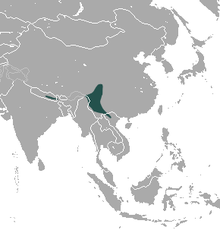Small brown-toothed shrew
| Small brown-toothed shrew | ||||||||||||
|---|---|---|---|---|---|---|---|---|---|---|---|---|
| Systematics | ||||||||||||
|
||||||||||||
| Scientific name | ||||||||||||
| Episoriculus macrurus | ||||||||||||
| ( Blanford , 1888) |
The small brown-toothed shrew ( Episoriculus macrurus ) is a species of shrew from the genus Episoriculus . It is widespread in South Asia, in northern India and in Nepal, in central and southern China and in Myanmar.
features
With a head-torso length of 4.7 to 7.3 centimeters, the small brown-toothed shrew is one of the medium-sized shrew species. The tail reaches a length of 7.6 to 10.1 centimeters and the hind foot from 1.4 to 1.8 centimeters. The back and belly color is uniformly light gray. The tail is about 1.5 times as long as the head-trunk length and is very long compared to all other species in the genus.
The skull has a maximum length of 17 to 19 millimeters and is thus about as large as that of other species in the genus.
distribution
Episoriculus macrurus is distributed over parts of the high mountains of South Asia, Central China and parts of the north of Southeast Asia. The area extends in South Asia from North India from Darjeeling in West Bengal to Nepal . In the People's Republic of China , the species is found in the provinces of Sichuan and Yunnan , and the species also lives in the north of Myanmar and Vietnam .
Way of life
The preferred habitat of the small brown-toothed shrew is at medium to high altitudes, where it mainly inhabits temperate evergreen deciduous and low rhododendron forests. Like other shrews, the species is adapted to a soil lifestyle, but it can also be found in bushes near water and the long tail and body indicate a partially semi- arboreal way of life. Sometimes it occurs sympatric with the somewhat larger Hodgsons brown tooth shrew ( Episoriculus caudatus ).
The diet consists mainly of earthworms and other invertebrates. There is hardly any data available on reproduction; the females probably have up to six young with one litter.
Systematics
The small brown-toothed shrew is classified as an independent species within the genus Episoriculus , which consists of four species. The first scientific description comes from William Thomas Blanford from 1888.
Apart from the nominate form, no subspecies are distinguished within the species .
Threat and protection
The species is classified by the International Union for Conservation of Nature and Natural Resources (IUCN) as “least concern” due to its relatively large distribution area in Asia and the assumed population size. Threats to the species are not known and a significant decline in populations is not assumed; regionally, especially in South Asia, it can be endangered by habitat changes.
literature
- Robert S. Hoffmann, Darrin Lunde: Long-tailed Mountain Shrew. In: Andrew T. Smith , Yan Xie: A Guide to the Mammals of China. Princeton University Press, Princeton NJ 2008, ISBN 978-0-691-09984-2 , p. 311.
Web links
- Episoriculus macrurus in the Red List of Threatened Species of the IUCN 2012.2. Posted by: S. Molur, 2008. Retrieved June 16, 2013.
supporting documents
- ↑ a b c d Robert S. Hoffmann, Darrin Lunde: Long-tailed Mountain Shrew. In: Andrew T. Smith , Yan Xie: A Guide to the Mammals of China. Princeton University Press, Princeton NJ 2008, ISBN 978-0-691-09984-2 , p. 311.
- ↑ a b c Episoriculus macrurus in the Red List of Threatened Species of the IUCN 2012.2. Posted by: S. Molur, 2008. Retrieved June 16, 2013.
- ↑ a b c Episoriculus macrurus ( Memento of the original from November 10, 2013 in the Internet Archive ) Info: The archive link was inserted automatically and has not yet been checked. Please check the original and archive link according to the instructions and then remove this notice. . In: Don E. Wilson , DeeAnn M. Reeder (Eds.): Mammal Species of the World. A taxonomic and geographic Reference. 2 volumes. 3. Edition. Johns Hopkins University Press, Baltimore MD 2005, ISBN 0-8018-8221-4 .
